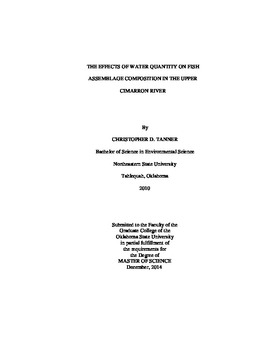| dc.contributor.advisor | Long, James M. | |
| dc.contributor.author | Tanner, Christopher | |
| dc.date.accessioned | 2016-01-20T15:45:06Z | |
| dc.date.available | 2016-01-20T15:45:06Z | |
| dc.date.issued | 2014-12-01 | |
| dc.identifier.uri | https://hdl.handle.net/11244/25725 | |
| dc.description.abstract | Many prairie streams suffer from altered flow regimes as a result of surface and groundwater extraction for irrigation. Changes in flow regimes can alter resident fish assemblage structure and abundance. To determine the effect of water withdrawal on the resident fish assemblage of the upper Cimarron River, I developed and pursued two objectives: 1) quantify the magnitude of stream flow loss in the upper Cimarron River and its effect on the fish assemblage and 2) determine concurrent fish assemblage differences among sites that differ in water quantity. To quantify stream flow loss, I identified a temporal change in stream flow using segmented regression and Indicators of Hydrologic Alteration (IHA) software to compare two periods surrounding the temporal change ("pre" and "post-impact") to determine the magnitude. To determine the effect of stream flow loss on the resident fish assemblage, upper Cimarron River fish collection records from Oklahoma State University, the University of Oklahoma, and the University of Kansas were separated by date into pre and post-impact communities and then compared. To compare concurrent fish assemblage differences among sites with different water quantities, I sampled the Ditch Valley area of the Cimarron River where a diversion of stream flow into an irrigation canal provides four distinct sample sites with different water flows (upstream, canal, diverted river, and downstream). Temperature, salinity, and discharge were measured for each site. Fish were sampled using a seine bi-monthly between May 2012 and December 2012, with an additional sampling in June 2013. A significant change in upper Cimarron River stream flow was detected in 1986, resulting in decreased flows and a change in fish assemblage structure. Post-impact assemblage favored tolerant species able to adapt to reduced water flows. Flow reductions appear to be correlated with of increased groundwater withdrawal for irrigation. Historical drought made comparisons of Ditch Valley fish communities difficult, but general trends were apparent. Species richness was positively correlated with water quantity and fish occurrence in the simplified habitat of the canal was most likely related to entrainment or food resource availability. | |
| dc.format | application/pdf | |
| dc.language | en_US | |
| dc.publisher | Oklahoma State University | |
| dc.rights | Copyright is held by the author who has granted the Oklahoma State University Library the non-exclusive right to share this material in its institutional repository. Contact Digital Library Services at lib-dls@okstate.edu or 405-744-9161 for the permission policy on the use, reproduction or distribution of this material. | |
| dc.title | Effects of Water Quantity on Fish Assemblage Composition in the Upper Cimarron River | |
| dc.type | text | |
| dc.contributor.committeeMember | Echelle, Anthony A. | |
| dc.contributor.committeeMember | Tobler, Michael | |
| osu.filename | Tanner_okstate_0664M_13689.pdf | |
| osu.accesstype | Open Access | |
| dc.description.department | Natural Resources and Ecology Management | |
| dc.type.genre | Thesis | |
